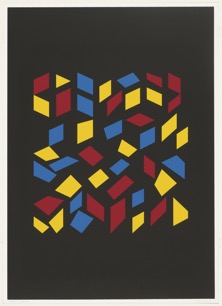
Connections 1925/1983- Orchestra III, 1983
Connections 1925/1983- Orchestra III, 1983
Screenprint
69.5 x 49.5 cm
The Josef and Anni Albers Foundation, Bethany, Connecticut
Being creative is not so much the desire to do something as the listening to that which wants to be done: the dictation of the materials. Anni Albers
Known especially for her pioneering role in Fiber Art, her innovations in the treatment of wefts, and her permanent search for textile motifs and functions, Anni Albers (Berlin, 1899–Orange, Connecticut, 1994) is fundamental for the redefinition of the figure of the artist as designer. During her career, besides her weavings, she also made pieces of jewelry, drawings and prints. In addition, she formalized her theories on fiber art in writings that are now basic for understanding the development of this type of art, such as her book On Weaving.
In 1963, Anni went with her husband, Josef Albers, also an artist, to visit the Tamarind lithography workshop in Los Angeles. There she discovered engraving, a technique that allowed her to investigate and experiment with new forms she had been unable to achieve with textiles. In the many techniques of engraving, Albers found a new space for visual investigation. Engraving also allowed her to create several copies of a single work, and this in turn opened up the possibility of democratizing the artistic object and so erasing the fine line separating art from design. The artist found an interesting parallel between between the industrialization of the textile-making process, which she was in favor of, and the technique of engraving. Besides her hand-woven work, she also made large numbers of designs intended for subsequent production on industrial looms, since she was a supporter of mechanical textile production. Through her work, Albers promoted a dual role for fiber artists, who would concentrate on the one hand on the production of cloth samples for the industry, and on the other on creating works of fiber art.
From 1964, and until the end of her life, Anni Albers devoted her attention to graphic work, although she returned on several occasions to the textile medium, which she never completely abandoned. In the mid-1970s, after Josef’s death, Anni fell gravely ill, but after a long spell in hospital she returned to her engraving. She started making abstract prints again, but the principal motif now was a four-sided figure, which she used in different variations for the series of works she called Orchestra. This series was inspired by the 1920s, when Anni and her sister, still in Germany, used to go to the opera in Berlin. The shapes and colors evoke the instruments tuning up, the elegant velvet and lace dresses of the women attending the performance, and other images. In all these works, the artist heightens the colors with printing machinery, applying the ink in several separate print runs, and adding varnish in a further run so as to make the black as intense as possible.
Preguntas
Look at Orchestra III (1983), and describe it. What do you see? Describe how Anni Albers has used color in this piece. Does it suggest a state of mind to you, or any particular feeling or sensation? Does this palette or combination of colors remind you of anything specific?
The title of the work is Orchestra III (1983). How does your way of looking at the picture change once you know the title? Do you think Albers shows any of the possible qualities of the orchestra in her print? Give reasons for your answer.
The Orchestra series evokes the time around the year 1920, when the young Anni and her sister would go to the opera in Berlin. What do you imagine it would have been like to live in that city then? Would you have liked to be there? What do you think those concerts were like? How do you think people dressed to go and see an orchestra? What sounds, smells, and colors do you imagine Anni might be evoking with her work?
One very important discovery for Albers was that with engravings, the artistic object can be democratized and the problematical division between art and design can be erased. What do you think about this? Does it seem important to you to democratize access to art? Why do you think blurring the separation between art and design was seen as a major part of this process? Albers was a key figure in the redefinition of the artist as designer. Do you think there are currently any noticeable differences between artists and designers?
